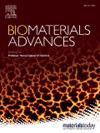含氯化小檗碱的硅氧烷改性聚乙烯醇/聚多巴胺多孔水凝胶,表现出强大的抗菌活性,促进mrsa感染伤口愈合
IF 6
2区 医学
Q2 MATERIALS SCIENCE, BIOMATERIALS
Materials Science & Engineering C-Materials for Biological Applications
Pub Date : 2025-07-18
DOI:10.1016/j.bioadv.2025.214418
引用次数: 0
摘要
先进、新颖、有效的伤口敷料减少伤口感染是临床应用的必要条件。本研究以聚乙烯醇(PVA)、聚多巴胺(PDA)和多孔二氧化硅(PSi)为基础,设计了一种多功能水凝胶,负载小檗碱氯(Bbn),用于治疗mrsa感染的伤口。通过溶胶-凝胶法和自聚合法制备PVA@PSi/PDA-Bbn水凝胶,形成多孔、粘接、光热响应的基质。在近红外照射下,水凝胶表现出良好的溶胀行为、机械强度和持续的Bbn释放。通过抗菌活性、病理评估和参与细胞增殖和伤口愈合的关键蛋白的表达来评价水凝胶的疗效。这些蛋白包括cyclin D1、c-Myc、Max、FGF-1、β-catenin、WNT-1和COL1A。水凝胶的物理化学性质证实了它们的成功合成和生物医学应用的适用性。溶胀性、流变性、粘接强度、安全性和抗菌活性的测试结果证实了该水凝胶是合适的。PVA@PSi40/PAD-Bbn水凝胶通过抑制细胞周期蛋白D1、c-Myc、Max、FGF-1、β-catenin和COL1-A的表达,促进伤口愈合。总之,PVA@PSi40/PAD-Bbn可以与莫匹罗星软膏®竞争,加速mrsa伤口愈合过程。它具有药物释放控制、组织粘连强、抑制MRSA有效促进创面愈合等优点,优于常规治疗。本文章由计算机程序翻译,如有差异,请以英文原文为准。

Porous hydrogel of siloxane-modified polyvinyl alcohol/polydopamine containing berberine chloride, exhibiting robust antibacterial activity and promoting the healing of MRSA-infected wounds
Advanced and novel effective wound dressings that decrease wound infections are essential for clinical application. In this study, a multifunctional hydrogel was engineered based on polyvinyl alcohol (PVA), polydopamine (PDA), and porous silica (PSi), loaded with berberine chloride (Bbn), for the treatment of MRSA-infected wounds. The PVA@PSi/PDA-Bbn hydrogel was fabricated via sol-gel and self-polymerization methods, forming a porous, adhesive, and photothermal-responsive matrix. The hydrogel demonstrated excellent swelling behavior, mechanical strength, and sustained Bbn release under NIR irradiation. The efficacy of the hydrogels was evaluated through antibacterial activity, pathological assessments, and the expression of key proteins involved in cell proliferation and wound healing. These proteins included cyclin D1, c-Myc, Max, FGF-1, β-catenin, and WNT-1, and COL1A. The physicochemical properties of the hydrogels confirmed their successful synthesis and suitability for biomedical applications. The results for swelling, rheological properties, adhesive strength, safety, and antibacterial activity confirmed the hydrogels to be appropriate. The PVA@PSi40/PAD-Bbn hydrogel could enhance the healing process through its antibacterial activity and modulation of the expressions of cyclin D1, c-Myc, Max, FGF-1, β-catenin, and COL1-A. In sum, PVA@PSi40/PAD-Bbn could compete with the mupirocin ointment® and accelerate the MRSA-wound healing process. It showed better performance than conventional treatments by providing controlled drug release, strong tissue adhesion, and effective MRSA inhibition to promote wound healing.
求助全文
通过发布文献求助,成功后即可免费获取论文全文。
去求助
来源期刊
CiteScore
17.80
自引率
0.00%
发文量
501
审稿时长
27 days
期刊介绍:
Biomaterials Advances, previously known as Materials Science and Engineering: C-Materials for Biological Applications (P-ISSN: 0928-4931, E-ISSN: 1873-0191). Includes topics at the interface of the biomedical sciences and materials engineering. These topics include:
• Bioinspired and biomimetic materials for medical applications
• Materials of biological origin for medical applications
• Materials for "active" medical applications
• Self-assembling and self-healing materials for medical applications
• "Smart" (i.e., stimulus-response) materials for medical applications
• Ceramic, metallic, polymeric, and composite materials for medical applications
• Materials for in vivo sensing
• Materials for in vivo imaging
• Materials for delivery of pharmacologic agents and vaccines
• Novel approaches for characterizing and modeling materials for medical applications
Manuscripts on biological topics without a materials science component, or manuscripts on materials science without biological applications, will not be considered for publication in Materials Science and Engineering C. New submissions are first assessed for language, scope and originality (plagiarism check) and can be desk rejected before review if they need English language improvements, are out of scope or present excessive duplication with published sources.
Biomaterials Advances sits within Elsevier''s biomaterials science portfolio alongside Biomaterials, Materials Today Bio and Biomaterials and Biosystems. As part of the broader Materials Today family, Biomaterials Advances offers authors rigorous peer review, rapid decisions, and high visibility. We look forward to receiving your submissions!

 求助内容:
求助内容: 应助结果提醒方式:
应助结果提醒方式:


